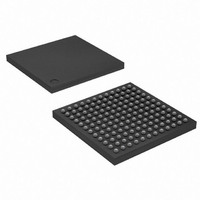AT91SAM9R64-CU Atmel, AT91SAM9R64-CU Datasheet - Page 306

AT91SAM9R64-CU
Manufacturer Part Number
AT91SAM9R64-CU
Description
MCU ARM9 64K SRAM 144-LFBGA
Manufacturer
Atmel
Series
AT91SAMr
Specifications of AT91SAM9R64-CU
Core Processor
ARM9
Core Size
16/32-Bit
Speed
240MHz
Connectivity
EBI/EMI, I²C, MMC, SPI, SSC, UART/USART, USB
Peripherals
AC'97, POR, PWM, WDT
Number Of I /o
49
Program Memory Size
32KB (32K x 8)
Program Memory Type
ROM
Ram Size
72K x 8
Voltage - Supply (vcc/vdd)
1.08 V ~ 1.32 V
Data Converters
A/D 3x10b
Oscillator Type
Internal
Operating Temperature
-40°C ~ 85°C
Package / Case
144-LFBGA
Processor Series
AT91SAMx
Core
ARM926EJ-S
Data Bus Width
32 bit
Data Ram Size
64 KB
Interface Type
2-Wire, SPI, SSC, USART
Maximum Clock Frequency
240 MHz
Number Of Programmable I/os
118
Number Of Timers
4
Maximum Operating Temperature
+ 85 C
Mounting Style
SMD/SMT
3rd Party Development Tools
JTRACE-ARM-2M, MDK-ARM, RL-ARM, ULINK2
Development Tools By Supplier
AT91SAM-ICE, AT91-ISP, AT91SAM9RL-EK
Minimum Operating Temperature
- 40 C
On-chip Adc
10 bit, 3 Channel
Controller Family/series
AT91SAM9xxx
No. Of I/o's
49
Ram Memory Size
64KB
Cpu Speed
240MHz
No. Of Timers
3
Rohs Compliant
Yes
Package
144LFBGA
Device Core
ARM926EJ-S
Family Name
91S
Maximum Speed
240 MHz
Operating Supply Voltage
1.8|3.3 V
For Use With
AT91SAM-ICE - EMULATOR FOR AT91 ARM7/ARM9
Lead Free Status / RoHS Status
Lead free / RoHS Compliant
Eeprom Size
-
Lead Free Status / Rohs Status
Lead free / RoHS Compliant
Available stocks
Company
Part Number
Manufacturer
Quantity
Price
Part Number:
AT91SAM9R64-CU
Manufacturer:
ATMEL/爱特梅尔
Quantity:
20 000
- Current page: 306 of 903
- Download datasheet (13Mb)
29.7.3.2
29.7.3.3
29.7.3.4
306
AT91SAM9R64/RL64 Preliminary
Interrupt Nesting
Interrupt Vectoring
Interrupt Handlers
The nIRQ line can be asserted only if an interrupt condition occurs on an interrupt source with a
higher priority. If an interrupt condition happens (or is pending) during the interrupt treatment in
progress, it is delayed until the software indicates to the AIC the end of the current service by
writing the AIC_EOICR (End of Interrupt Command Register). The write of AIC_EOICR is the
exit point of the interrupt handling.
The priority controller utilizes interrupt nesting in order for the high priority interrupt to be handled
during the service of lower priority interrupts. This requires the interrupt service routines of the
lower interrupts to re-enable the interrupt at the processor level.
When an interrupt of a higher priority happens during an already occurring interrupt service rou-
tine, the nIRQ line is re-asserted. If the interrupt is enabled at the core level, the current
execution is interrupted and the new interrupt service routine should read the AIC_IVR. At this
time, the current interrupt number and its priority level are pushed into an embedded hardware
stack, so that they are saved and restored when the higher priority interrupt servicing is finished
and the AIC_EOICR is written.
The AIC is equipped with an 8-level wide hardware stack in order to support up to eight interrupt
nestings pursuant to having eight priority levels.
The interrupt handler addresses corresponding to each interrupt source can be stored in the reg-
isters AIC_SVR1 to AIC_SVR31 (Source Vector Register 1 to 31). When the processor reads
AIC_IVR (Interrupt Vector Register), the value written into AIC_SVR corresponding to the cur-
rent interrupt is returned.
This feature offers a way to branch in one single instruction to the handler corresponding to the
current interrupt, as AIC_IVR is mapped at the absolute address 0xFFFF F100 and thus acces-
sible from the ARM interrupt vector at address 0x0000 0018 through the following instruction:
When the processor executes this instruction, it loads the read value in AIC_IVR in its program
counter, thus branching the execution on the correct interrupt handler.
This feature is often not used when the application is based on an operating system (either real
time or not). Operating systems often have a single entry point for all the interrupts and the first
task performed is to discern the source of the interrupt.
However, it is strongly recommended to port the operating system on AT91 products by support-
ing the interrupt vectoring. This can be performed by defining all the AIC_SVR of the interrupt
source to be handled by the operating system at the address of its interrupt handler. When doing
so, the interrupt vectoring permits a critical interrupt to transfer the execution on a specific very
fast handler and not onto the operating system’s general interrupt handler. This facilitates the
support of hard real-time tasks (input/outputs of voice/audio buffers and software peripheral han-
dling) to be handled efficiently and independently of the application running under an operating
system.
This section gives an overview of the fast interrupt handling sequence when using the AIC. It is
assumed that the programmer understands the architecture of the ARM processor, and espe-
cially the processor interrupt modes and the associated status bits.
LDR
PC,[PC,# -&F20]
6289C–ATARM–28-May-09
Related parts for AT91SAM9R64-CU
Image
Part Number
Description
Manufacturer
Datasheet
Request
R

Part Number:
Description:
MCU, MPU & DSP Development Tools KICKSTART KIT FOR AT91SAM9 PLUS
Manufacturer:
IAR Systems

Part Number:
Description:
DEV KIT FOR AVR/AVR32
Manufacturer:
Atmel
Datasheet:

Part Number:
Description:
INTERVAL AND WIPE/WASH WIPER CONTROL IC WITH DELAY
Manufacturer:
ATMEL Corporation
Datasheet:

Part Number:
Description:
Low-Voltage Voice-Switched IC for Hands-Free Operation
Manufacturer:
ATMEL Corporation
Datasheet:

Part Number:
Description:
MONOLITHIC INTEGRATED FEATUREPHONE CIRCUIT
Manufacturer:
ATMEL Corporation
Datasheet:

Part Number:
Description:
AM-FM Receiver IC U4255BM-M
Manufacturer:
ATMEL Corporation
Datasheet:

Part Number:
Description:
Monolithic Integrated Feature Phone Circuit
Manufacturer:
ATMEL Corporation
Datasheet:

Part Number:
Description:
Multistandard Video-IF and Quasi Parallel Sound Processing
Manufacturer:
ATMEL Corporation
Datasheet:

Part Number:
Description:
High-performance EE PLD
Manufacturer:
ATMEL Corporation
Datasheet:

Part Number:
Description:
8-bit Flash Microcontroller
Manufacturer:
ATMEL Corporation
Datasheet:

Part Number:
Description:
2-Wire Serial EEPROM
Manufacturer:
ATMEL Corporation
Datasheet:











